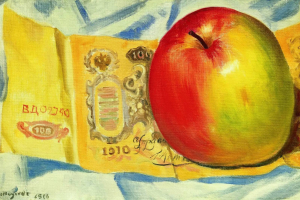Even though inflation has been successfully contained, consumer price growth in the top developed economies is still significantly above the target. The current wave of global inflation has affected (link in Russian) all the major developed countries, where the acceleration of price growth began in the first half of 2021. When inflation peaked in the fall of 2022, consumer prices in the developed countries had not risen so quickly in at least 40 years, or since the early 1980s. Such a spike in inflation is particularly surprising given that, over the past decade and a half (up to the pandemic), central banks have made special efforts to boost inflation. However, the quantitative easing programmes and low rates did not have the desired result, and inflation remained exceptionally low, significantly deviating from the target. It is also noteworthy that eminent think tanks and central banks were unable to foresee (link in Russian) how strong and long the inflation shock would be.
Although there has been a slowdown in inflation this year, it is still abnormally high. In other words, the period of inflation is still far from over, and so a number of natural questions arise. What factors caused this extraordinary surge in inflation? When will it finally be contained and when will interest rates return to neutral levels? What scenarios seem likely in the medium term? Will this crisis have any long-term consequences, or will macroeconomic conditions return in a few years to what we saw in the 2010s? Sergey Drobyshevsky (Gaidar Institute, Institute of Applied Economic Research, RANEPA), Pavel Trunin (Gaidar Institute, Institute of Applied Economic Research, RANEPA), Alexei Kudrin (Gaidar Institute, New Economic School), and I try to answer these questions in our paper.
We identify three qualitatively distinct scenarios.
The first assumes that central banks will be able to effectively fight inflation and normalise interest rates. In the second scenario, inflation will be more persistent and will remain elevated for a longer time. Finally, in the third scenario, the economies of the key developed countries will fall into the stagflation trap, which will result in output growth rates that are close to zero and inflation that is significantly higher than the target. Let us take a closer look at each of these three scenarios and the variables that affect their materialisation.
Medium term
The first scenario is both the most optimistic and the most likely. Today, the pro-inflation effects have largely been exhausted. Following the demand slump brought on by the lockdowns in 2020, the phase of rapid demand recovery is now over. Supply-side constraints are easing as tensions in global supply chains subside, the labour market gradually returns to normal, and commodity prices decline from the peaks of the past two years. Concurrently, central banks are maintaining high rates and intend to bring inflation to the target in accordance with their mandates.
Inflation expectations assume that the high inflation observed today is a temporary phenomenon, so it does not cause concern among economic agents. Thus, there is much evidence that consumer price dynamics in the key developed economies will stabilise over the next two years.
The second scenario is based on the idea that higher inflation will be more resistant than expected by monetary authorities and experts. This option cannot be ruled out. The likelihood that it materialises depends on whether the fragmentation of global trade worsens and whether geopolitical tensions reach a new level. These factors will contribute to cost-push inflation and may trigger a new round of inflation. Much will depend on the policies of central banks. Will they promptly and markedly react to an acceleration in price growth, or will they prefer to wait it out?
One characteristic of supply shocks is the poor predictability of their consequences, not least because supply shocks are still poorly described by contemporary economic mathematical models, which make them better suited for modelling demand shocks. In this regard, it seems quite possible that the regulators will not raise rates in response to an adverse supply shock, fearing a deepening recession and believing that the effect of the pro-inflation factors will be short-lived. This, in turn, will lead to additional price increases, and the return of inflation to the target will take more time. It should be noted that the duration and strength of the inflation shock of recent years were largely caused by the wait-and-see attitude of the monetary authorities.
The main risks associated with the second scenario stem from the possible loss of the inflation anchor and the initiation of the pro-inflation mechanism that economists call the ‘wage-price spiral’. These two factors are, of course, directly related to one another, since a significant rise in inflation expectations is required for a stable wage-price spiral (link in Russian) to form. In this case, when they set nominal wages, employers will also take into account expectations for future increases in consumer prices in addition to the inflation that has already occurred.
However, higher inflation expectations do not develop instantly. The process takes a certain amount of time. The main driver of this change in inflation expectations is the increased actual inflation observed by economic agents. In other words, inflation expectations are largely adaptive, and if economic agents notice an acceleration in the growth of consumer prices, after some time they will conclude that these increased rates are now normal, and they will adjust their expectations accordingly. Empirical studies show that inflation expectations are quite flexible in reality, so there is a real risk that they become unstable.
According to economists, the ability of the monetary authorities of the developed countries to uphold price stability is primarily determined by the stability (or ‘anchoring’) of inflation expectations.
When economic agents are confident that inflation will return to moderate levels in the medium term, they are more tolerant of price fluctuations and do not change their behaviour, believing that these events are irregular and temporary. If the expectations of producers, investors, and consumers were more flexible, even a small pro-inflation shock would trigger an increase in inflation expectations and, as a result, a significant increase in demand, imbalances, and overheating.
However, high inflation expectations significantly reduce the room for stimulus policy during recessions, since the higher inflation expectations are, the greater the risk that stimulus will destabilise markets and prices. As a result, managing economic development becomes much harder when inflation expectations are not properly anchored. If the anchor is lost, many problems will get worse. If these risks materialise, which does not seem very likely, the situation will unfold as predicted by the stagflation (third) scenario.
Stagflation of the 1970s and lessons learnt
The wave of inflation in 2021–2023 is often compared to the stagflation period of the 1970s in the United States, which was known as the ‘Great Inflation’, similar to the ‘Great Depression’. The stagflation period lasted for almost two decades in total, and in addition to the high inflation and weak and unstable economic growth rates, it also brought about the fall of the Bretton Woods system, which served as the foundation for the world’s financial system. Only thanks to Paul Volcker’s tight monetary policy was the high inflation finally brought to an end. Raising policy rates to double-digit levels caused price dynamics to return to normal, but at the same time, it sent the US economy into a recession and hit employment.
It is easy to compare the situation in 2021–2023 to the stagflation of the 1970s, with rising energy prices, other negative supply shocks, and the need to finance large budget deficits. Unlike in the 1970s, the top central banks now understand that price stability depends primarily on them. However, as 2021 has shown, they may still delay policy rates increases, believing that the inflation surge is only temporary and that monetary tightening will harm the economy rather than help it. Besides, high interest rates increase the risk of losing financial stability.
Regulators today, of course, have a much better understanding of the influence of the monetary policy on the economy compared to the 1970’s. They pay a lot of attention to tracking inflation expectations and enjoy much greater autonomy from fiscal authorities. So, while a repeat of the stagflation scenario is unlikely, in our opinion, it is still important to understand that it is possible.
Deglobalisation and potential output growth rates
The problems and challenges that the central banks of the developed countries will face in the longer term depend on how potential output and the neutral interest rate change. The greatest difficulties, from the perspective of the monetary authorities, arise when the growth of potential output is slow and the neutral rate of interest is close to zero. Both inflation and the nominal rate drop to near-zero values under these conditions, significantly reducing the effectiveness of monetary policy. A return to unconventional monetary policy measures at zero rates should be expected in the event that the macroeconomic conditions in the developed countries return to such a state after the inflation shock is overcome.
One of the most significant factors in the materialisation of this scenario is the ongoing shift towards renewable energy sources, which is intensifying as a result of the rise in geopolitical risks and their effects on the world energy market. Even though central bankers do not currently find it appealing, it is possible that the idea of raising the target rate for inflation will gain more support in the expert community.
However, it is still possible that the neutral rate will be raised. As nominal rates are hiked and central banks have more leeway to act when demand declines, maintaining price stability becomes simpler. Higher rates would also require more stringent quantitative tightening measures. This would strain financial institutions that have been operating in an environment of excess liquidity for many years and would have a negative impact on fiscal sustainability.
The direction of changes in the rates of potential output growth is also unclear. First, the process of globalisation has slowed down recently, and in certain ways we can even speak of a shift away from it. The segmentation of the global market and the decrease in the mobility of financial capital will have a negative impact on the rate of potential output growth and will put upward pressure on the neutral rate.
Second, given the rise in geopolitical tensions, government spending on defence and the military-industrial complex are also likely to increase significantly, which will ramp up both the potential GDP growth and the neutral rate.
As a result, there is still a high degree of uncertainty regarding not only the dynamics of consumer prices but also regarding structural macroeconomic trends and the monetary policy agenda for the coming years.
The full text of the article is published in Voprosy Ekonomiki, No. 7, 2023.







